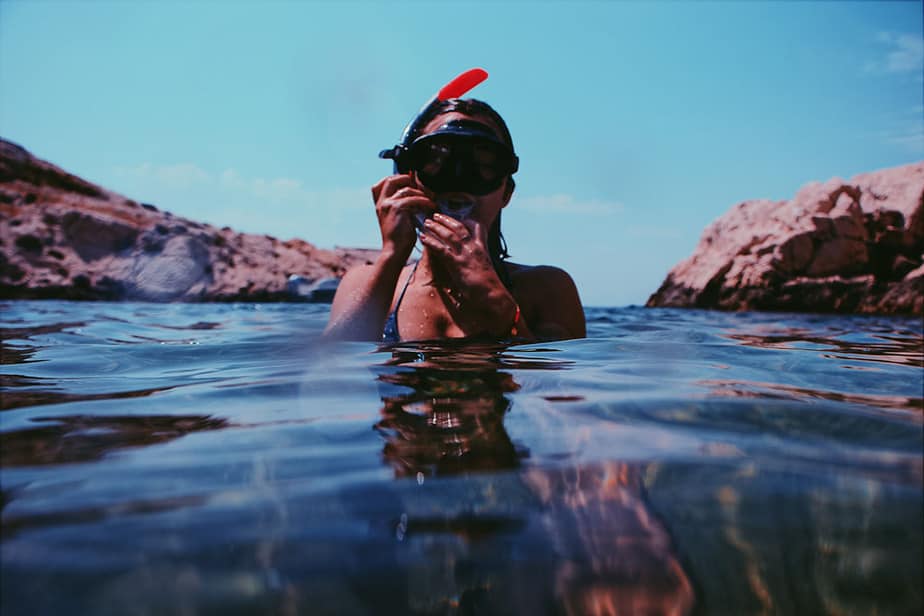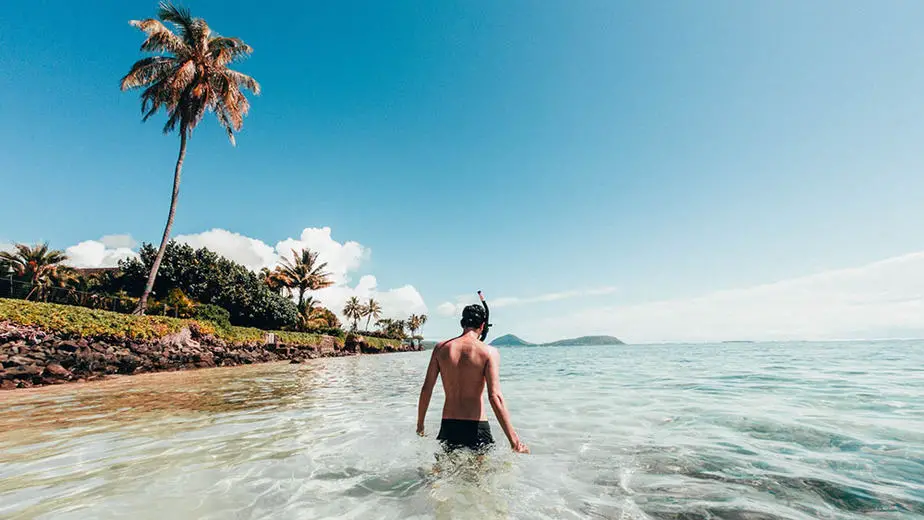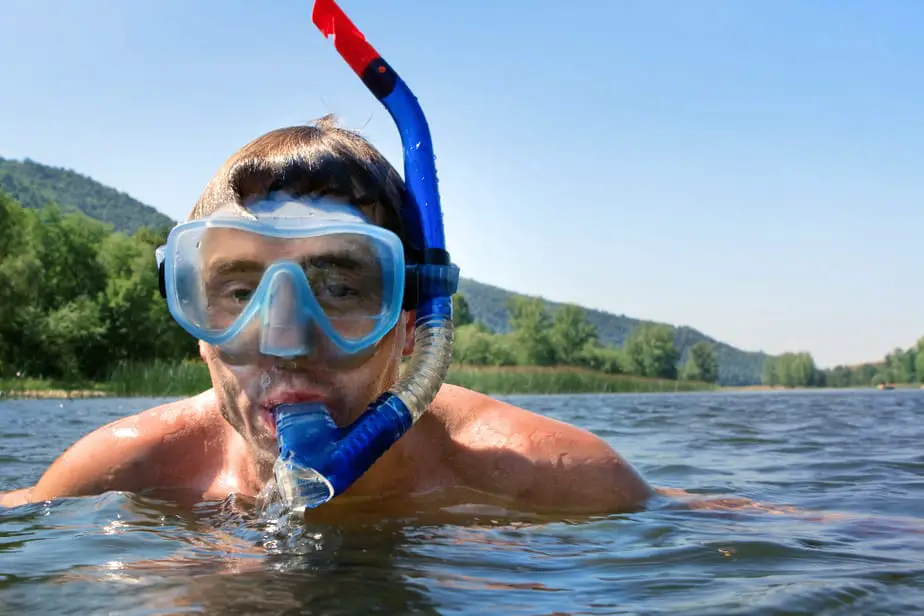If you think about it, a snorkel is just a tube one can use to breathe underwater. Think of it like a supersized straw. Humans have been using “snorkels” in one way or another for centuries. Back then, they used hollow reed tubes but the concept is the same today. It’s so basic and intuitive, most people don’t really think about how it works.
Today, snorkels are designed to be durable, easy-to-use, and reliable. Designers have considered everything from the optimal tube length for effective gas exchange, comfortable and sterile mouthpieces, to safeguards that keep water from flooding in should you submerge too far or if a rogue wave splashes you. Our ancestors would marvel at the souped up snorkels we have today. So how does a snorkel work today? In this article, we will go over the innovations we’ve made over the years and how they make snorkeling a safer and enjoyable hobby.
How Snorkels Work: An Overview
All modern snorkels have some similar components, and they are the mouthpiece, main tube, and a mask clip that lets it connect to a snorkel or dive mask. Traditional snorkels, sometimes just called J-snorkels, are composed of only these parts.
Main Tube
In the past, the main tube was completely straight, with a J-curve only near the mouthpiece. Today, snorkels have a more contoured shape that ergonomically bends around your face and connects to your mask.
No matter how the snorkel is shaped, it is designed to let gas flow between your mouth and the surface air. It is the reason why your face can be submerged underwater yet still capable of receiving fresh oxygen.
When breathing through a snorkel, your lungs have to work a bit harder since the air must travel through a long tube before it reaches it. In order for your lungs to receive sufficient oxygen to keep your blood and muscles oxygenated, you must breathe deeply. If you have some kind of lung disease or you are out of shape, you might find it hard to breathe through a snorkel.
These are some reasons why it is not possible to make a snorkel that is incredibly long, allowing you to be deeper underwater. Anything longer than a foot (in Europe, the limit is 38cm) and you will start to encounter difficulties with breathing.
Next, not only would it be a struggle to inhale oxygen from the surface, but there is also the issue of expelling stale air. The longer the tube, the more carbon dioxide (CO2) will accumulate in the tube such that you will end up breathing it back in instead of fresh oxygen. It will feel like you are breathing through a blocked tube, and eventually you will asphyxiate.
Lastly, there is also the issue of increased water pressure at greater depths. One must breathe pressurized oxygen (from a pump or tank) when diving and trying to breathe surface-pressure air from an exceptionally long snorkel won’t work since your lungs will struggle to inflate while under so much pressure.

Mouthpiece
Next up, we have the mouthpiece. Made from high-quality, soft silicone, modern mouthpieces are durable and more comfortable than rubber. Furthermore, it is hypoallergenic and easy to sterilize. You can even detach them for easier cleaning or replace them completely if you damage it.
Most mouthpieces share a similar design with two bite tabs to rest your teeth on and a flap that seals against the inside of your lips. Depending on the brand, you can expect slightly different shapes for better comfort and ergonomics.
For instance, some high end mouthpieces have bite tabs that are soft and can mold around the shape of your teeth, customizing its fit to better suit you specifically. Another example is AquaLung’s Comfo-Bite mouthpieces that have bigger silicone panels that don’t rely on you to bite down on them with your teeth to stay in place.
How do you know if a mouthpiece fits you properly? When wearing one, you should not have to bite down very hard or stretch your lips to fit around it. Your jaw and lips should be relaxed and you should not feel any pain. If you find it too uncomfortable, it may be too big for you or the silicone is too stiff. Mouthpieces are generally one-size-fits-all, however there may be smaller mouthpieces you can substitute in.
Mask Attachment
Snorkels come with a mask clip that can quickly and reliably attach or detach from your mask. Fancier clips may provide functionality to pivot for increased comfort.
Breathing with A Snorkel Underwater
So now that you know a bit about a snorkel’s components, let’s talk about how to actually use it. While snorkeling, you must breathe deeply to get an adequate amount of oxygen. Deep breaths will increase the chances that all of the air in the tube is exchanged (oxygen in and carbon dioxide out) with each breath.
Ever find yourself lightheaded or drowsy while snorkeling? It may be a sign that you are not getting enough oxygen. If you are not breathing deeply enough, carbon dioxide can get trapped in the tube and you may be breathing in too much stale air. Essentially, you are slowly asphyxiating and need to surface immediately.
To reduce the chances of this happening, look for a snorkel that is an appropriate size for your lungs. Larger snorkels work better for larger people that have greater lung capacity and so on. Unless you have incredibly powerful lungs, look for a lower volume snorkel (shorter tube length). You should also be practicing how to breathe deeply or train your lungs by doing cardiovascular training.

How Do Classic Snorkels Work?
Classic “wet” snorkels or J-tube snorkels have the bare minimum components consisting of a main tube, mask clip, and mouthpiece. Slightly better models may have a purge valve and a flexible tube, though these features are standard fare for higher-end semi-dry and dry snorkels.
Traditionals snorkels are often used in sports that rely on breath holding, such as spearfishing or freediving. As a result, they are designed to be narrower, lighter, and shorter than their dry and semi-dry counterparts. This allows air to be fully exchanged with each breath. Another benefit is that there will not be any trapped air adding unwanted buoyancy in the tube.
The Purge Valve
One downside of having such a minimalist design is that classic snorkels often lack a purge valve. Purge valves allow water to be expelled where the valve is (close to the mouthpiece). Without one, you must expel the water out of the top whenever it fills up. This requires more effort and practice to successfully clear the tube and beginners may struggle with it.
As such, the people most suited for using classic snorkels are experienced snorkelers that enjoy diving down a few meters underwater. It is also ideal for spearfishes or freedivers. Lastly, due to the minimalist and lightweight design, some people may simply enjoy the slimmer design. Those who feel like their snorkels are too bulky or heavy should consider using a classic snorkel instead.
How Do Semi-Dry Snorkels Work?
Next, semi-dry snorkels are a hybrid between the classic snorkel and a dry snorkel. In addition to the components of a classic snorkel, you can expect semi-dry snorkels to include flex tubes, purge valves, and splash guards.
The Splash Guard
The splash guard is a molded piece of plastic fitted over the top of the snorkel tube. It has numerous angled slits that allow air to flow through while directing water away. This design will keep most of the water from splashes, sprays, the rain, or choppy waves from entering the tube, though water will still flood in if you are completely submerged.
The Purge Valve
Furthermore, semi-dry snorkels typically come with a purge valve. They are typically found below the mouthpiece in a reservoir that collects stray water that enters. When you exhale from your mouth, the valve will open and purge the excess water from the reservoir. Compared to the classic snorkel, this simplifies tube clearing since the water has another opening it can exit the snorkel from.
The Flex Tube
You may find flex tubes on all snorkels, but they are almost always found on dry and semi-dry snorkels. While they aren’t mandatory for snorkelers, they do provide you with the option to adjust how the mouthpiece is positioned, making the overall fit more comfortable. Additionally, this lets the mouthpiece dangle away from your face when you aren’t using it.
Some people find the dangling mouthpiece to be irritating, while others hate having the mouthpiece in front of their face when not in use. The only time the flex tube is mandatory is if you are doing SCUBA activity so that it won’t get in the way of your regulator.
Usage
Semi-dry snorkels are often used by scuba divers who want to conserve the oxygen in their tank while near the surface who don’t like the bulkiness of a dry snorkel. They can also be used by snorkelers that enjoy duck-diving but who also want some protection against rogue waves. Semi-dry snorkels are highly versatile and can be used for nearly any underwater activity.
Thanks to this, the first snorkel you ever used was probably a semi-dry snorkel. Whether you are a beginner or advanced snorkeler, it can be used by anyone to great effect. For casual water activities, the dangling mouthpiece allows you to surface and have a breather or chat with a buddy without getting in the way. You can get them in numerous sizes and styles, and the slimmer designs are ideal for breath-hold activities.
How Do Dry Snorkels Work?
What is a dry snorkel and how does it work? Dry snorkels contain all of the features that a semi-dry snorkel has, but it has a new addition in the form of the float valve. The float valve is what makes a snorkel truly “dry”.
The float valve mechanism is located at the top of the tube where the splash guard is. Once submerged, the float valve will seal the opening, completely cutting off all water and air from entering the tube.
The benefit is that it keeps water from entering unexpectedly such as when a large wave rolls over you or you accidentally submerge too far. The downside is that you may suddenly find yourself struggling to breathe because you didn’t notice the float valve has sealed the opening. So how exactly does a float valve work?
How A Float Valve Works
Though the exact method may differ slightly depending on the brand and model, all dry valves rely on buoyancy to seal and open the snorkel tube. When submerged, the buoyant material, called a float, will rise to the top. This float is connected to a hinge mechanism that pushes and pulls a flap that seals and opens the opening.
Thus, as you submerge, the float will rise to the top of the tube and seal the opening before any water can make it inside. As you rise above the water’s surface, the float will fall down and open the tube to allow air to flow through once again. This process is completely automatic and makes it so you almost never have to clear a dry snorkel.
Diving with a Dry Snorkel
When diving with the other snorkels, water will invariably flood in and you must clear the tube in order to breathe through it again, which some may find annoying. However, diving with a dry snorkel has its own share of problems. As the float valve seals the opening, there will be some lingering air that adds unwanted buoyancy to the snorkel.
This creates a slight resistance when diving and will constantly pull the snorkel upwards. Where one problem is addressed, another arises, making dry snorkels even worse for diving than its counterparts.
Some people have confused the name “dry” snorkel for a snorkel that can allow you to breathe underwater. While you may be able to get another breath using the air trapped inside, overall you cannot breathe underwater with a dry snorkel.
Usage
Dry snorkels are best used for snorkeling only along the surface. They are well-suited for complete beginners who struggle with clearing water and who don’t want to accidentally choke on water.
Snorkel with peace of mind knowing that rogue waves or accidental submersion won’t cause you to inhale a mouthful of water. The downside of a dry snorkel is that it is heavier and bulkier than the other snorkels.
Furthermore, in rare situations the float valve mechanism can malfunction, causing the seal to close when it shouldn’t, or to remain sealed even after surfacing. To fix this, you may have to give it a shake or be prepared to surface and fix the snorkel by hand.
Full-Face Snorkel Masks
Within the last decade, full-face snorkel masks have become quite popular. As the name suggests, it is a mask that covers your entire face, allowing you to breath with either your mouth or nose. Additionally, it has a dry snorkel built into the mask, located at the top. They are yet another option available for beginners who don’t want the hassle of buying a mask and snorkel separately.
You can read about the differences between a full-face mask and traditional snorkel mask here.
How Does a Snorkel Work? – Recap
In this guide, you learned about the basic components of a snorkel and how it works. There are three main types: classic (wet), semi-dry, and dry. All snorkels have a tube, mouthpiece, and mask clip.
In addition, semi-dry snorkels have a purge valve and splash guard. Dry snorkels have all of those as well as a float valve. With a dry snorkel, you never have to worry about clearing water ever again.
Most snorkels have a flex tube which allows the mouthpiece to dangle away from your face when not in use. This is useful for SCUBA diving or for having a quick chat with your buddy at the surface without a mouthpiece in your way.
The tube of the snorkel is not very long, around a foot in length, and this allows air to be fully exchanged with each breath. This also prevents stale air from accumulating in the dead space of the tube. Without a purge valve, clearing the tube can be challenging for a beginner.
The most popular type of snorkel is the semi-dry snorkel due to its versatility. Lastly, dry snorkels are highly recommended surface only activity and for beginners that want to snorkel with peace of mind that they won’t choke on water.


